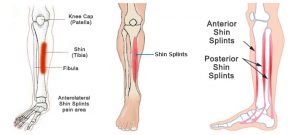SHIN SPLINTS; symptoms, causes, risk factors, prevention, and treatment
 SHIN SPLINTS
SHIN SPLINTS
Shin splints is quite common for those starting a new exercise routine, or for regular exercisers who increase their exercise intensity too quickly.
Below is an easy to read and accurate explanation I came across on the net
Symptoms
If you have shin splints, you might notice tenderness, soreness or pain along the inner side of your shinbone and mild swelling in your lower leg. At first, the pain might stop when you stop exercising. Eventually, however, the pain can be continuous and might progress to a stress reaction or stress fracture.
Causes
Shin splints are caused by repetitive stress on the shinbone and the connective tissues that attach your muscles to the bone.
Risk factors
You’re more at risk of shin splints if:
- You’re a runner, especially one beginning a running program
- You suddenly increase the duration, frequency or intensity of exercise
- You run on uneven terrain, such as hills, or hard surfaces, such as concrete
- You’re in military training
- You have flat feet or high arches
Prevention
To help prevent shin splints:
- Analyze your movement. A formal video analysis of your running technique can help to identify movement patterns that can contribute to shin splints. In many cases, a slight change in your running can help decrease your risk.
- Avoid overdoing. Too much running or other high-impact activity performed for too long at too high an intensity can overload the shins.
- Choose the right shoes. If you’re a runner, replace your shoes about every 350 to 500 miles (560 to 800 kilometers).
- Consider arch supports. Arch supports can help prevent the pain of shin splints, especially if you have flat arches.
- Consider shock-absorbing insoles. They might reduce shin splint symptoms and prevent recurrence.
- Lessen the impact. Cross-train with a sport that places less impact on your shins, such as swimming, walking or biking. Remember to start new activities slowly. Increase time and intensity gradually.
- Add strength training to your workout. Exercises to strengthen and stabilize your legs, ankles, hips and core can help prepare your legs to deal with high-impact sports or activities.